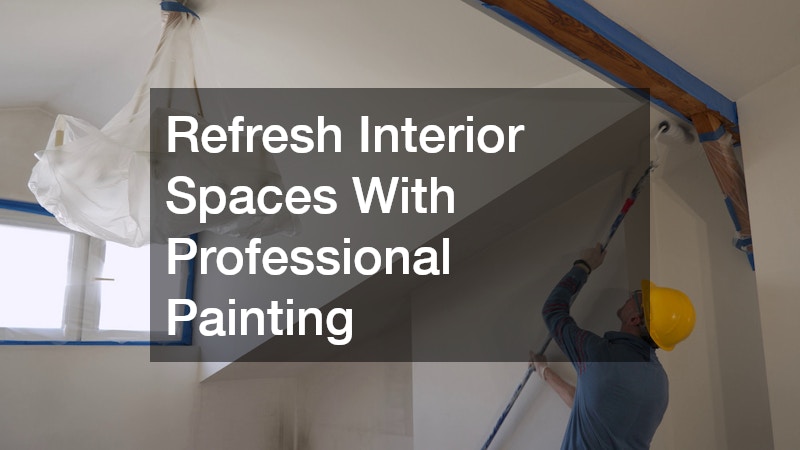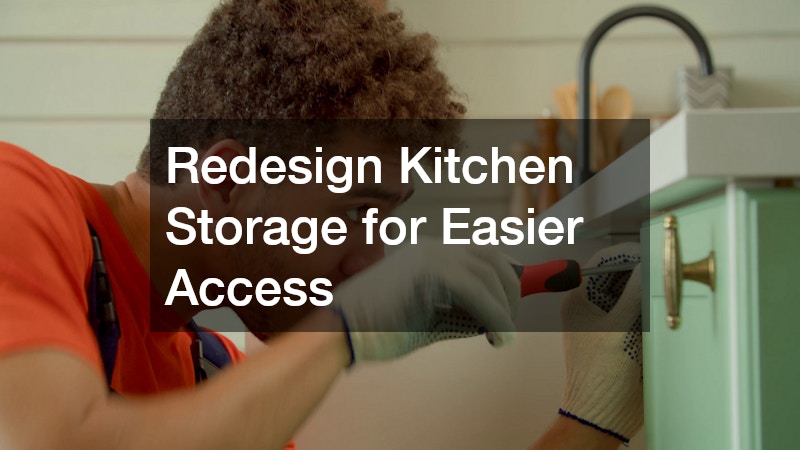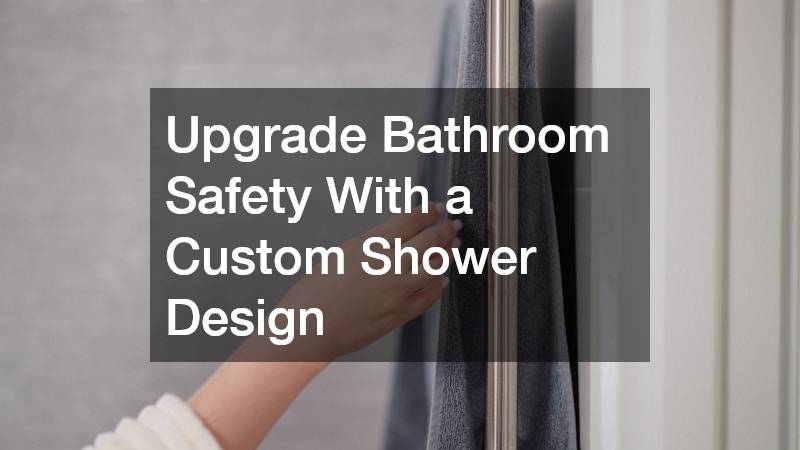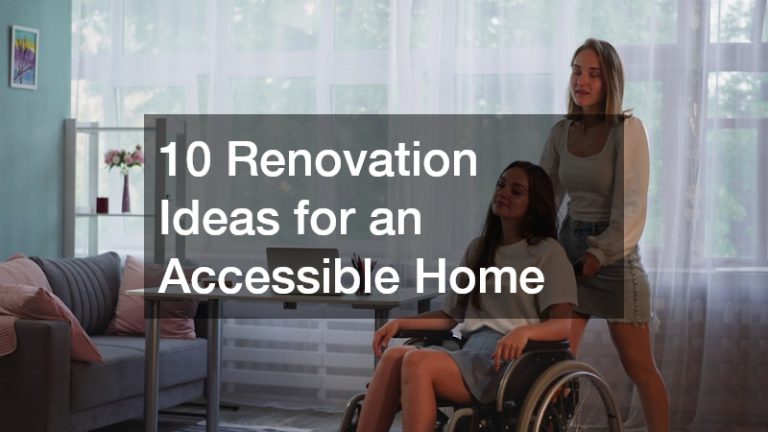
Transforming a residence into an accessible home involves more than simply meeting physical requirements—it’s about creating a living space that promotes comfort, independence, and safety for everyone. Accessibility touches all aspects of daily life, from moving through hallways and staircases to cooking, bathing, and sleeping with ease. A thoughtfully planned home improves usability while maintaining a stylish, cohesive environment. Renovations that address accessibility also enhance long-term value, reduce the risk of injury, and make day-to-day tasks simpler and more enjoyable.
Planning an accessible home requires careful attention to detail. Consider elements such as lighting, flooring, and spatial flow to ensure that rooms are easy to navigate. The choices you make should balance aesthetics and functionality, creating spaces that are both inviting and practical. Whether renovating a single room or conducting a full-scale home remodel, implementing accessibility improvements now can help accommodate changing needs over time. These strategies also enhance quality of life, making your home a place where everyone can move freely and safely.
1. Refresh Interior Spaces With Professional Painting

Updating wall colors and finishes is a simple yet impactful way to improve the look and feel of an accessible home. Thoughtfully chosen paint can increase visibility, create a calming atmosphere, and define areas within open spaces. Light, neutral shades often brighten rooms and reduce visual fatigue, while accent walls or contrasting colors around doorways and baseboards can help individuals with visual impairments identify room boundaries more easily. Finishes also matter: matte paints reduce glare, while semi-gloss or satin options are easier to clean and maintain in high-traffic areas. A cohesive color palette enhances flow and makes moving through the home more intuitive, contributing to both safety and aesthetics.
Working with painting contractors ensures the application is precise and efficient, particularly in homes where accessibility modifications are involved. Professionals can recommend low-VOC paints to improve air quality, which is especially beneficial for residents with respiratory sensitivities. Contractors may also provide guidance on accent colors that highlight pathways, emphasize steps, or visually differentiate zones, adding subtle cues that make navigation easier. By updating walls, ceilings, and trim with purpose, you not only enhance the beauty of your home but also improve its functionality and livability for all residents.
2. Improve Energy Efficiency Through Window Upgrades
Upgrading windows is a practical renovation that supports both comfort and safety in an accessible home. Proper lighting is essential, and windows that maximize natural light reduce the risk of falls while creating a more inviting atmosphere. Energy-efficient windows help regulate indoor temperatures, which is particularly important for individuals sensitive to heat or cold. Easy-to-operate windows improve independence, allowing residents to control ventilation without assistance. Selecting the right materials and placement ensures that every room feels open, well-lit, and comfortable, enhancing the overall functionality of the home.
Investing in double pane window repair significantly boosts energy efficiency and comfort. These windows insulate against temperature fluctuations and reduce drafts, making it easier to maintain a consistent indoor climate. They also minimize external noise, creating a peaceful environment that supports daily routines and rest. For Combining upgraded windows with automatic blinds or accessible handle designs can further enhance usability. Repairs or replacements ensure that windows operate smoothly and reliably, providing a long-term solution that improves comfort, reduces utility costs, and contributes to an overall safer living space.
3. Enhance Entryways Using Custom Door Solutions

Improving entryways is a critical step in making a home more accessible. Wider openings, smooth thresholds, and strategically placed lighting increase ease of movement and reduce the risk of accidents. Entryways serve as transitional spaces, so their design should support both aesthetics and functionality. For example, incorporating clear lines of sight and visually contrasting surfaces can help individuals with limited vision navigate independently. A well-designed entryway also enhances curb appeal while ensuring residents and guests can enter and exit comfortably and safely.
Installing custom sliding doors can transform how a household interacts with entryways. Unlike traditional doors that require clearance space to swing open, sliding doors operate along tracks and conserve floor area, which is particularly useful in smaller or high-traffic rooms. Custom designs allow for ergonomic handles, automated or soft-close mechanisms, and materials that complement the overall style of the home. For an accessible home, these doors can simplify navigation, improve access for mobility devices, and increase independence, all while maintaining a sleek, modern aesthetic. Properly installed sliding doors provide both practicality and elegance, enhancing safety and everyday convenience.
4. Increase Mobility by Installing a Stair Lift System
Stairs are often a barrier in multi-level homes, limiting accessibility for residents with mobility challenges. Enhancing movement between floors is essential for creating a fully functional accessible home. Safety features such as sturdy handrails, adequate lighting, and non-slip surfaces are helpful, but they do not fully address the challenges faced by those who cannot easily climb stairs. Adding mechanical solutions can eliminate physical strain, provide independence, and ensure that all areas of the home are usable.
A stair lift is a reliable way to improve vertical mobility. Modern models are designed to accommodate various staircase shapes and dimensions while remaining compact when not in use. Features such as safety belts, swivel seats, and remote operation increase usability and reduce the risk of accidents. Stair lifts can also be tailored for comfort, including padded seating and adjustable speed controls. By installing a stair lift, homeowners ensure that individuals with limited mobility can access every level of the house safely and independently, making it an essential component of a well-designed home.
5. Redesign Kitchen Storage for Easier Access

The kitchen is one of the most frequently used areas in the home, making accessibility improvements here particularly impactful. Redesigning storage, counter heights, and appliance placement can facilitate safer and more efficient use. Wide pathways, clear sightlines, and intuitive organization enhance maneuverability, especially for individuals using mobility aids. The goal is to create a kitchen that is functional, comfortable, and safe, allowing residents to prepare meals, access supplies, and maintain independence.
Upgrading kitchen cabinets plays a central role in accessibility. Pull-down shelves, sliding drawers, and soft-close mechanisms make it easier for users to reach essential items without stretching or bending excessively. Custom cabinetry can also be adjusted to suit specific mobility requirements, ensuring that storage is within reach and ergonomically practical. In an accessible home, these thoughtful modifications reduce strain, improve organization, and maintain a clean, attractive kitchen environment. Functional cabinetry upgrades promote independence while complementing the overall design aesthetic of the space.
6. Select Comfortable and Practical Home Furnishings
Furnishing an accessible home involves more than aesthetics—it’s about enhancing safety, mobility, and comfort throughout the space. Furniture choices should consider reachability, stability, and ergonomic support, particularly for residents with limited strength or flexibility. Open layouts with minimal obstructions improve flow, while well-chosen pieces can enhance both visual appeal and functionality. Accessibility also prioritizes durability and adaptability, ensuring that furnishings continue to meet evolving needs over time.
Shopping at local discount furniture stores can offer cost-effective options without compromising quality. Affordable pieces with adjustable heights, supportive seating, and non-slip surfaces improve usability and reduce the risk of injury. Storage furniture that is easy to access also supports independence by allowing residents to manage their belongings without assistance. By thoughtfully selecting furniture that meets these standards, homeowners can create a home that balances comfort, functionality, and style for all residents and visitors.
7. Upgrade Bathroom Safety With a Custom Shower Design

Bathrooms are high-risk spaces in any home, and ensuring safety here is essential in an accessible home. Features like grab bars, slip-resistant flooring, adequate lighting, and strategically positioned fixtures enhance usability and prevent accidents. Designing the bathroom with accessibility in mind also improves comfort and independence, allowing residents to perform daily hygiene routines confidently and safely. A functional and well-organized bathroom supports overall well-being and makes a home more inclusive.
Installing a custom shower door improves both safety and convenience. These doors can accommodate walk-in designs, barrier-free entries, and wider openings, reducing the need for stepping over high thresholds. Materials can be selected for durability and grip, while designs may include sliding or folding options to save space. Combined with other accessibility features such as fold-down seats and handheld showerheads, a custom shower door contributes to a bathroom that is safe, comfortable, and easy to use, enhancing the overall accessibility of the home.
8. Enhance Bedroom Comfort With Specialized Features
The bedroom is a critical space for rest, relaxation, and recovery, and accessibility upgrades here can significantly improve quality of life. Considerations include bed height, the space surrounding furniture, storage accessibility, and lighting. Clear pathways and organized layouts make it easier for residents to move safely, reducing the risk of injury. Thoughtful bedroom design ensures that an accessible home supports comfort and independence for all residents.
Incorporating a special needs bed can greatly improve sleep quality and safety. Adjustable heights, built-in safety rails, and supportive mattresses make it easier to get in and out of bed independently. Some models include tilt or lift mechanisms to assist with mobility and positioning, which is particularly valuable for individuals with limited strength or flexibility. Specialized beds, combined with accessible storage and lighting, create a bedroom that is both practical and comfortable, enhancing the functionality and overall accessibility of the home.
9. Install Durable Railings for Safety
Safety within a home relies on structural supports as well as functional furniture and appliances. Railings provide stability along stairs, ramps, and hallways, helping prevent falls and guiding movement for those with limited vision or balance. Strategically placed railings also create a sense of security, allowing residents to move confidently throughout the home. Thoughtfully designed railings can complement the aesthetic of the home while serving an essential functional purpose.
Partnering with experts in railing fabrication ensures that these safety features are custom-designed to fit the home’s specific needs and the unique layout of each space. Materials and designs can be carefully selected for durability, comfort, and visual appeal, blending seamlessly with the home’s interior style while providing essential support. Railings can be adjusted in height, thickness, and grip style to accommodate all users, ensuring stability and security in key areas such as staircases, ramps, and hallways. Thoughtful placement and craftsmanship also help guide movement and create a sense of structure throughout the home. By installing well-crafted railings, homeowners enhance both the safety and functionality of a home, creating an environment where residents can move freely and confidently while maintaining independence and peace of mind.
10. Optimize Indoor Comfort Using Expert Climate Control
Temperature and air quality are key elements in a comfortable, accessible home. Proper climate control supports health, prevents discomfort, and allows residents to manage their environment independently. Adequate airflow, zoned temperature control, and easy-to-use thermostats contribute to daily comfort, while careful system design ensures that all areas of the home maintain consistent temperatures. Optimizing climate systems is an essential step in creating a home that is both functional and welcoming.
Hiring HVAC contractors to install or upgrade heating, ventilation, and air conditioning systems provides energy-efficient, reliable solutions. Professionals can recommend zoning systems, programmable thermostats, and high-quality filters that improve air quality and overall comfort. Homes benefit from quiet, efficient systems that allow residents to adjust conditions with minimal effort. Well-designed HVAC upgrades ensure that indoor environments are comfortable year-round, supporting health, safety, and independence for every member of the household.
Designing for accessibility is about more than compliance—it’s about creating a space that promotes independence, safety, and comfort while remaining stylish and welcoming. From painting and window upgrades to custom doors, stair lifts, specialized bedroom furniture, and climate control, each improvement enhances functionality and livability. Every detail, from bathroom safety to furniture layout and railings, contributes to a home that adapts to the changing needs of its residents while providing peace of mind and convenience.
By prioritizing accessibility in every renovation, homeowners can create a living environment that meets current needs and anticipates future challenges. Thoughtful design ensures that all residents can navigate safely, perform daily tasks independently, and enjoy a high quality of life. With the right guidance and professional support, we at Road Solutions Paving can help you implement accessible home upgrades that combine safety, comfort, and style, making your home a truly inclusive space for everyone.
